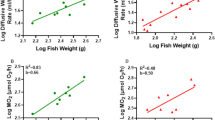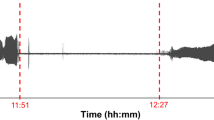Abstract
The French Atlantic coast contains large highly productive intertidal mudflats that are colonised by juveniles of numerous flatfish species, including the common sole (Solea solea, L.). These ecosystems are also heavily exploited by the shellfish farming industry. Intensive bivalve culture is associated with substantial biodeposition (1–6 t-dw ha−1 day−1), which directly or indirectly contributes to increase exopolysaccharide (EPS) concentrations at the interface between water column and seabed. EPS are long-chain molecules organised into colloids, which influence rheological properties of water, particularly viscosity. Increased water viscosity had consequences for ventilatory activity of juvenile flatfish, whereby the minimal pressure required to ventilate the medium increases directly with EPS concentration. Moreover, the critical EPS concentration ([EPS]crit) at which water was no longer able to flow through the branchial basket ranged from almost nil to over 30 mg l−1, depending on species and size. [EPS]crit was lower in small individuals and individuals from species with high metabolic rates (turbot and plaice). These differences may depend upon gill and bucco-branchial cavity morphometrics. The ventilatory workload of sole increased with viscosity to a maximum at 2 mg EPS l−1. Viscosity might, therefore, be a limiting factor for flatfish post larvae, which colonise the intertidal mudflats, depending upon their size and species. EPS concentrations in the field can reach 15 mg l−1. A selective effect is conceivable but remains to be estimated in the field.








Similar content being viewed by others
Abbreviations
- \( {\text{\ifmmode\expandafter\dot\else\expandafter\.\fi{M}O}}_{2} \) :
-
Oxygen consumption in mgO2 per unit of time (h−1) and unit of mass (kg−1)
- \( \ifmmode\expandafter\dot\else\expandafter\.\fi{\gamma } \) :
-
Shear rate
- %:
-
Per cent
- °C:
-
Celsius degree
- cm:
-
Centimetre
- d:
-
Day
- dw:
-
Dry weight
- e:
-
Exponential
- g:
-
Gram
- H :
-
Difference in water height
- H 0 :
-
Initial difference in water height
- ha:
-
Hectare
- Hz:
-
Hertz
- km2 :
-
Square kilometre
- l:
-
Litre
- L.:
-
Linnaeus
- ml:
-
Millilitre
- mm:
-
Millimetre
- Pa:
-
Pascal
- T :
-
Time
- t:
-
Tonnes
- y, k:
-
Parameters to estimate, k is the radius of curvature, y the asymptote value, i.e. yield stress
- ΔP :
-
Difference in pressure
- μm:
-
Micron
References
Altamiras J, Axelsson M, Claireaux G, Lefrançois C, Mercier C, Farrell AP (2002) Cardiorespiratory status of triploid brown trout during swimming at two acclimation temperatures. J Fish Biol 60:102–116
Barillé L, Cognie B (2000) Revival capacity of diatoms in bivalve pseudofaeces and faeces. Diatom Res 15:11–17
Blair SGW (1933) On the nature of “Yield-Value”. J Appl Phys 4:113–118
Bougrier S, Geairon P, Deslou-Paoli JM, Bacher C, Jonquières G (1995) Allometric relationships and effects of temperature on clearance and oxygen consumption rates of Crassostrea gigas (Thunberg). Aquaculture 134:143–154
Carlson DJ (1987) Viscosity of sea-surface slicks. Nature 329:823–825
Decho AW (1990) Microbial exopolymer secretions in ocean environments: their role(s) in food webs and marine processes. Oceanogr Mar Biol Annu Rev 28:73–153
Dubois M, Gilles KA, Hamilton JK, Rebers PA, Smith F (1956) Colorimetric method for determination of sugars and related substances. Anal Chem 28:350–356
Fonds M, Cronie R, VA D, Van der Puyl P (1992) Metabolism, food consumption and growth of plaice (Pleuronectes platessa) and flounder (Platichthys flesus) in relation to fish size and temperature. Neth J Sea Res 29:127–143
Fuiman LA, Batty RS (1997) What a drag it is getting cold: partitioning the physical and physiological effects of temperature on fish swimming. J Exp Biol 200:1745–1755
Gershakov SM, Hatcher PG (1972) Improved technique for analysis of carbohydrates in sediments. Limnol Oceanogr 17:938–943
Gibson RN (1997) Behaviour and the distribution of flatfishes. J Sea Res 37:241–256
Goulletquer P, Le Moine O (2002) Shellfish farming and coastal zone management (CZM) development in the Marennes-Oleron bay and charentais sounds (Charente Maritime, France): a review of recent developments. Aquaculture Int 10:507–525
Guarini J-M, Blanchard G, Bacher C, Gros P, Riera P, Richard P, Gouleau D, Galois R, Prou J, Sauriau P-G (1998) Dynamics of spatial patterns of microphytobenthic biomass: interferences from geostatistical analysis of two comprehensive surveys in Marennes-Oléron Bay (France). Mar Ecol Prog Ser 166:131–141
Hartstein ND, Rowden AA (2004) Effect of biodeposits from mussel culture on macroinvertebrate assemblages at sites of different hydrodynamic regime. Mar Environ Res 57:339–357
Hughes GM (1960) A comparative study of gill ventilation in marine teleosts. J Exp Biol 37:28–45
Hughes GM (1966) The dimensions of fish gills in relation to their function. J Exp Biol 45:177–195
Hughes GM (1972) Morphometrics of fish gills. Respir Physiol 14:1–25
Hughes GM (1984) General anatomy of the gills. In: Hoar WS, Randall DJ (eds) Fish physiology. X, Gills—Part A, Anatomy, gas transfert and acid-base regulation. Academic, New York, pp 1–72
Hughes GM, Shelton G (1958) The mechanism of gill ventilation in three freshwater teleosts. J Exp Biol 35:807–823
Jenkinson I, Arzul G (1998) Effect of the flagellates Gymnodinium mikimotoi, Heterosigma akashiwo and Pavlova lutheri on flow through fish gills. In: Reguera B, Blanco J, Fernández ML, Wyatt T (eds) Proceedings of the 8th international conference on Harmful Algae. Xunta de Galicia, Pontevedro and Intergovernmental Oeanographic Commission of Unesco, Vigo, Spain, pp 425–428
Jenkinson I, Biddanda B (1995) Bulk-phase viscoelastic properties of seawater: relationship with plankton components. J Plankton Res 17:2251–2274
Jenkinson I, Claireaux G, Gentien P (2007) Biorheological properties of intertidal organic fluff on mud flats and its modification of gill ventilation in buried sole Solea solea. Mar Biol 150:471–485
Jensen FB, Nikinmaa M, Weber RE (1993) Environmental perturbations of oxygen transport in teleost fishes: causes, consequences and compensations. In: Rankin JC, Jensen FB (eds) Fish ecophysiology, vol 9. Chapman & Hall, London, UK, pp 161–179
Kalinin AL, Severi W, Guerra CDR, Costa MJ, Rantin FT (2000) Ventilatory flow relative to intrabuccal and intraopercular volumes in the Serrasalmid fish Piaractus mesopotamicus during normoxia and exposed to graded hypoxia. Rev Bras Biol 60:249–254
Le Hir P, Robert S, Chaumillon E, Walker P (2005) Etude pour la gestion dynamique des sédiments sur les côtes du bassin de Marennes-Oléron et le pertuis de Maumusson. Lot 4: mesures et analyses—Conchyliculture/envasements/sables. IFREMER—CREOCEAN—CLDG, La Rochelle
Lefrançois C, Claireaux G (2003) Influence of ambient oxygenation and temperature on metabolic scope and scope for heart rate in the common sole Solea solea. Mar Ecol Prog Ser 259:273–284
Leguerrier D, Niquil N, Boileau N, Rzeznik J, Sauriau P-G, Le Moine O, Bacher C (2003) Numerical analysis of the food web of an intertidal mudflat ecosystem on the Atlantic coast of France. Mar Ecol Prog Ser 273:147–162
MacCormack TJ, McKinley RS, Roubach R, Almeida-Val VMF, Val AL, Driedzic WR (2003) Changes in ventilation, metabolism, and behaviour, but not bradycardia, contribute to hypoxia survival in two species of Amazonian armoured catfish. Can J Fish Aqua Sci 81:272–280
Mallekh R, Lagardère J-P (2002) Effect of temperature and dissolved oxygen concentration on the metabolic rate of turbot and the relationship between metabolic scope and feeding demand. J Fish Biol 60:1105–1115
Massel SR (1999) Fluid mechanics for marine ecologists. Springer, Berlin
Maxime V, Pichavant K, Boeuf G, Nonnotte G (2000) Effects of hypoxia on respiratory physiology of turbot, Scophthalmus maximus. Fish Physiol Biochem 21:51–59
Osse JWM, Van den Boogaart JGM (1999) Dynamic morphology of fish larvae, structural implications of friction forces in swimming, feeding and ventilation. J Sea Res 55:156–174
Parker JG (1983) A comparison of methods used for the measurement of organic matter in marine sediment. Chem Ecol 1:201–210
Petersen JK, Bougrier S, Smaal AC, Garen P, Robert S, Larsen JEN, Brummelhuis E (2004) Intercalibration of mussel Mytilus edulis clearance rate measurements. Mar Ecol Prog Ser 267:187–194
Preide IG, Holliday FGT (1980) The use of new tilting tunnel respirometer to investigate some aspects of metabolism and swimming activity of the plaice (Pleuronectes platessa L.). J Exp Biol 85:295–309
Ragnarsson SA, Raffaelli D (1999) Effects of the mussel Mytilus edulis L. on the invertebrate fauna of sediments. J Exp Mar Biol Ecol 241:31–43
Roberts JL (1975) Active branchial and ram gill ventilation in fishes. Biol Bull US 148:85–105
Schmidt-Nielsen K (1998) Physiologie animale—Adaptation et milieux de vie. Dunod, Paris, France
Schlichting H (1987) Boundary-layer theory. McGraw-Hill, New York
Shingles A, McKenzie DJ, Claireaux G, Domenici P (2005) Reflex cardioventilatory responses to hypoxia in the flathead gray mullet (Mugil cephalus) and their behavioral modulation by perceived threat of predation and water turbidity. Physiol Biochem Zool 78:744–755
Sokal RR, Rohlf FJ (1995) Biometry: the principles and practice of statistics in biological research. W.H. Freeman and Company, New York
Sornin J-M (1983) Effet des biodépôts de l’hûitre Crassostrea gigas (Thunberg) sur l’accumulation de matières organiques dans les parcs du bassin de Marennes-Oléron. J Molluscan Stud 12A:185–197
Sornin J-M, Feuillet M, Héral M, Fardeau J-C (1986) Influence des cultures d’huîtres Crassostrea gigas sur le cycle du phosphore en zone intertidale: rôle de la biodéposition. Oceanol Acta 9:313–322
Underwood GJC (1994) Seasonnal and spatial variation in epipelic diatom assemblages in the Severn estuary. Diatom Res 9:451–472
Underwood GJC, Paterson DM (1993) Seasonnal changes in diatom biomass, sediment stability and biogenic stabilisation in the Severn estuary. J Mar Biol Assoc UK 73:871–887
Verger F (1968) Marais et wadden du littoral français. Etude de géomorphologie. Thèse de Doctorat, Biscaye Frères imprimeurs
Vouvé F (2000) Régénération benthique dans les vasières intertidales de Marennes-Oléron: nature de la matière organique, son impact sur la production et l’incorporation de l’ammonium. Doctorat, Océanologie, Perpignan
Webb PW (1988) Simple physical principles and vertebrate aquatic locomotion. Am Zool 28:709–725
Wilson RS, Kuchel LJ, Franklin CE, Davison W (2002) Turning up the heat on subzero fish: thermal dependence of sustained swimming in an Antarctic notothenioid. J Therm Biol 27:381–386
Acknowledgements
Authors would like to thank Y. Desaunay, J. Grison, G. Guillou and M. Bréret for their technical assistance, C.S.C. was the recipient of a Ph.D. fellowship from the Conseil Général de Charente Maritime. The financial support by the European Union, Directorate Fisheries, through contract QLRS-2002-00799, Project ETHOFISH, is also acknowledged.
Author information
Authors and Affiliations
Corresponding author
Additional information
Communicated by S. A. Poulet.
Rights and permissions
About this article
Cite this article
Couturier, C.S., Rouault, A., McKenzie, D. et al. Effects of water viscosity upon ventilation and metabolism of a flatfish, the common sole Solea solea (L.). Mar Biol 152, 803–814 (2007). https://doi.org/10.1007/s00227-007-0731-z
Received:
Accepted:
Published:
Issue Date:
DOI: https://doi.org/10.1007/s00227-007-0731-z




